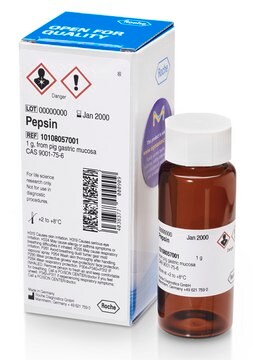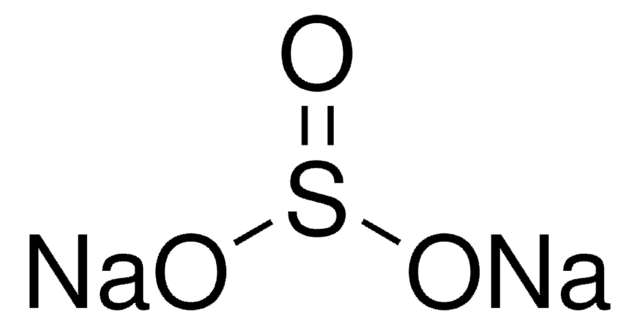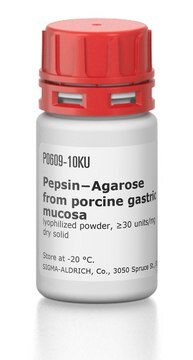77161
Pepsin from porcine gastric mucosa
tested according to Ph. Eur.
Synonym(s):
Pepsini pulvis, Pepsin A, Pepsin from hog stomach
Sign Into View Organizational & Contract Pricing
All Photos(1)
About This Item
Recommended Products
Agency
USP/NF
tested according to Ph. Eur.
form
powder
mol wt
35 kDa
UniProt accession no.
storage temp.
2-8°C
Gene Information
pig ... LOC396892(396892)
Looking for similar products? Visit Product Comparison Guide
Application
Pepsin cleavage can be used to produce F(ab′)2 fragments of antibodies. pepsin at www.sigma-aldrich.com/enzymeexplorer.
Biochem/physiol Actions
Preferential cleavage: hydrophobic and aromatic residues in P1 and P1′ postitions. Cleaves Phe-Val, Gln-His, Glu-Ala, Ala-Leu, Leu-Tyr, Tyr-Leu, Gly-Phe, Phe-Phe and Phe-Tyr bonds in the β chain of insulin
Analysis Note
Optimum pH is 2-4. Active in 4 M urea and 3 M guanidine HCl. Stable at 60 °C. Pepsin is irreversibly inactivated at pH 8.0 - 8.5.
Other Notes
Sales restrictions may apply
Signal Word
Danger
Hazard Statements
Precautionary Statements
Hazard Classifications
Eye Irrit. 2 - Resp. Sens. 1 - Skin Irrit. 2 - STOT SE 3
Target Organs
Respiratory system
Storage Class Code
11 - Combustible Solids
WGK
WGK 1
Flash Point(F)
Not applicable
Flash Point(C)
Not applicable
Personal Protective Equipment
dust mask type N95 (US), Eyeshields, Gloves
Choose from one of the most recent versions:
Already Own This Product?
Find documentation for the products that you have recently purchased in the Document Library.
Customers Also Viewed
Heather H Pua et al.
Cell reports, 26(4), 933-944 (2019-01-24)
Extracellular RNAs (exRNAs) can be released by numerous cell types in vitro, are often protected within vesicles, and can modify recipient cell function. To determine how the composition and cellular sources of exRNAs and the extracellular vesicles (EVs) that carry them
Liqing Zhou et al.
Behavioural brain research, 364, 374-382 (2018-01-18)
Accumulating evidence supports an increase in emotional and behavioral problems in patients with food allergy, but the underlying mechanism remains poorly understood. Here we found that in addition to inducing an increase of allergic factors in serum, food allergy also
Haiyu Qi et al.
Cell reports, 31(6), 107621-107621 (2020-05-14)
Follicular helper T cells (Tfhs) are essential for germinal center (GC) B cell maturation and antibody development. However, the intrinsic mechanisms that regulate Tfh differentiation are largely unknown. Here, we demonstrate that the frequencies of Tfhs and GC B cells, as
Xinghui Li et al.
Immunity, 50(3), 576-590 (2019-02-17)
Elevated glucose metabolism in immune cells represents a hallmark feature of many inflammatory diseases, such as sepsis. However, the role of individual glucose metabolic pathways during immune cell activation and inflammation remains incompletely understood. Here, we demonstrate a previously unrecognized
Chuan-Hsiao Han et al.
Food chemistry, 138(2-3), 923-930 (2013-02-16)
Our previous report showed that yam dioscorin and its peptic hydrolysates exhibit radical scavenging activities; however, the functions of these peptic hydrolases are still under investigation. In this study, the thiol-containing peptides derived from computer-aided simulation of pepsin hydrolysis of
Our team of scientists has experience in all areas of research including Life Science, Material Science, Chemical Synthesis, Chromatography, Analytical and many others.
Contact Technical Service









